1lumen selects and reviews products personally. We may earn affiliate commissions through our links, which help support our testing.
Fenix HM61R V2.0 review
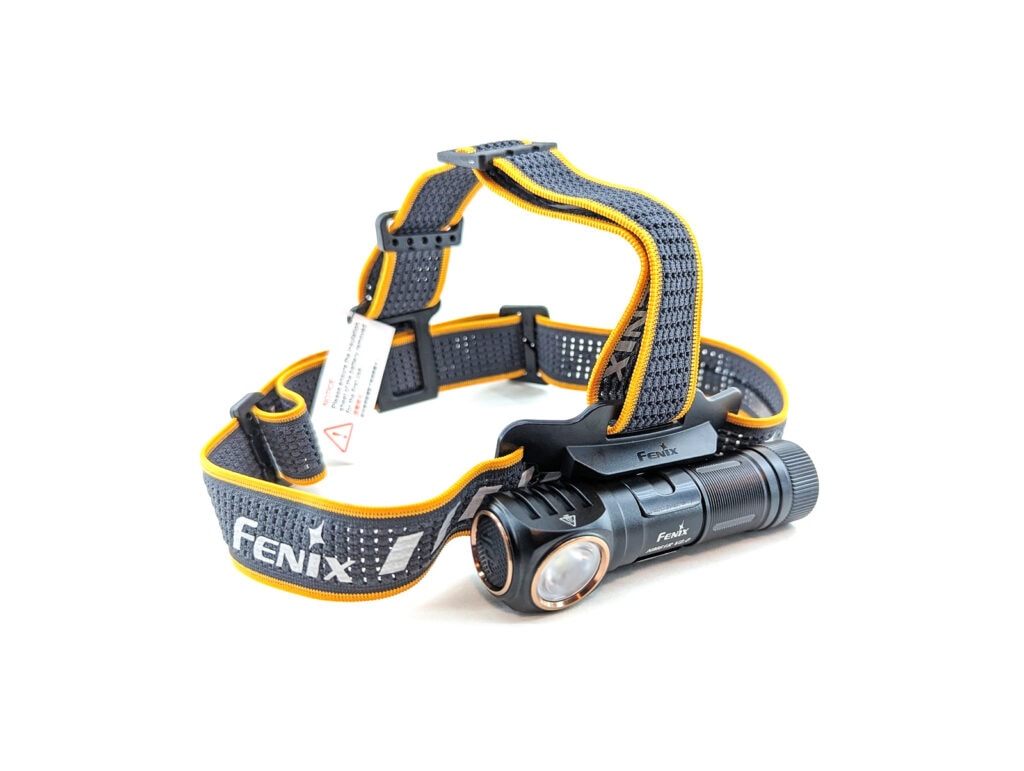
Fenix HM61R V2.0 specs
| Brand & Model | Fenix HM61R V2.0 |
|---|---|
| Flashlight category | Headlamp / work light |
| LED | Luminus SST40 + 2835 red LEDs |
| Max. output | 1600 lumens |
| Max. beam distance | 162 meters |
| Max. beam intensity | 6,566 cd |
| Battery config. | 1x 18650 / 2x CR123A |
| Onboard charging | Magnetic |
| Main modes | 5 white + 2 red |
| Blinkies | Red flash |
| Waterproof | IP68 |
| Review publication date | May 2023 |
Review intro:
Fenix makes a huge array of lights. In fact, they have an actual PDF catalog on their website (I imagine it’s probably also distributed in paper form as well) that is 48 pages long and chock-full of products ranging from tiny EDC lights all the way up to a couple really big boys that I’ve been fortunate enough to check out: the Fenix LR50R 12,000 lumen monstrosity and the Fenix HT30R 1500m throw LEP. If you need a light, chances are that Fenix will have a nice offering to fill that need. So check out all our Fenix flashlight reviews.
By and large, I really like Fenix – my first “real” flashlight was a Fenix (the 187 lumen E25 model, if you’re curious). From my experience, Fenix lights are really well designed, they use quality materials and finishes, have great constant-current drivers, and publish truthful ANSI specs. I’ve had the opportunity to review several different Fenix lights from their various lines, and I always come away impressed with their quality and attention to detail. I recently reviewed the HM60R, another Fenix headlamp. It was really nice, but considerably different than the headlamp we’re reviewing here – the brand-new Fenix HM61R V2.0. The HM61R V2.0 model, sounds like a full-featured right-angle headlamp with built-in charging and white + red modes.
Getting started with the Fenix HM61R V2.0 is pretty easy: just take it out of the box, unscrew the tailcap, and remove the insulating disc. Well, and put the tailcap back on.
Package quality.
The packaging for the Fenix HM61R V2.0 is instantly recognizable as having come off the same line as the other Fenix models that I recently reviewed. They used the same design language, though new materials this time around: a showy black and orange carton constructed not of cardboard, but of shiny plastic. I think it’s great that Fenix is using consistent packaging as it helps drive brand recognition. Arranged in the tray was:
- Fenix HM61R V2.0
- Fenix ARB-L18-3400 18650 battery (pre-installed)
- Headband
- Charging cable
- Spare o-ring
- Manual and other literature
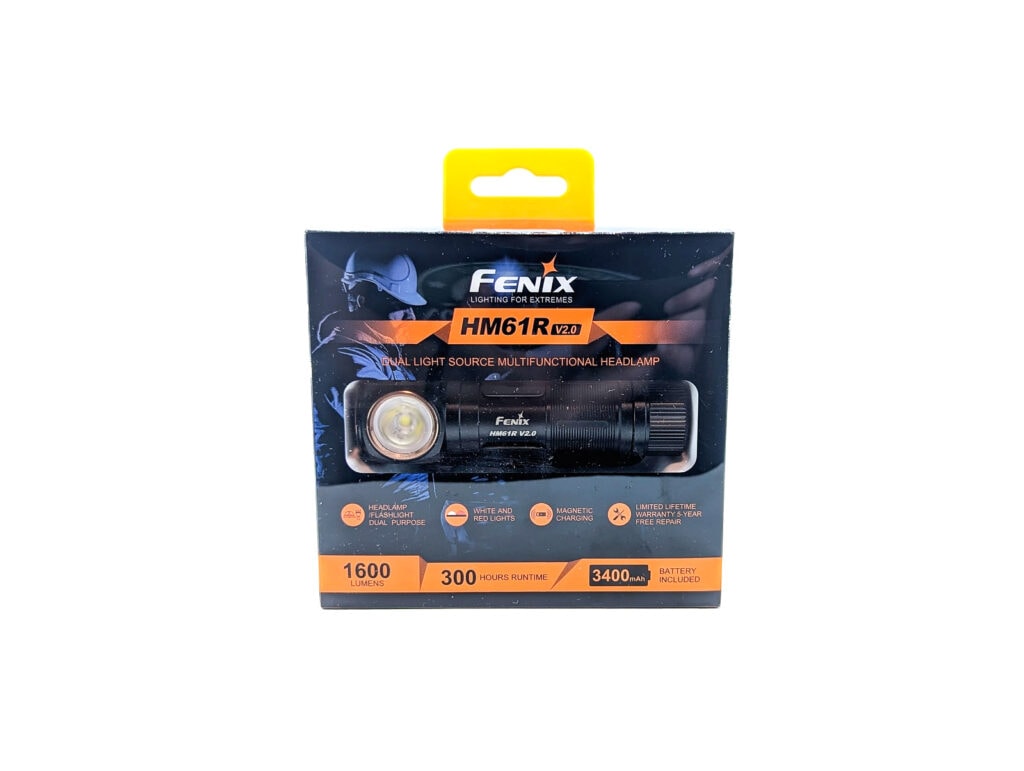
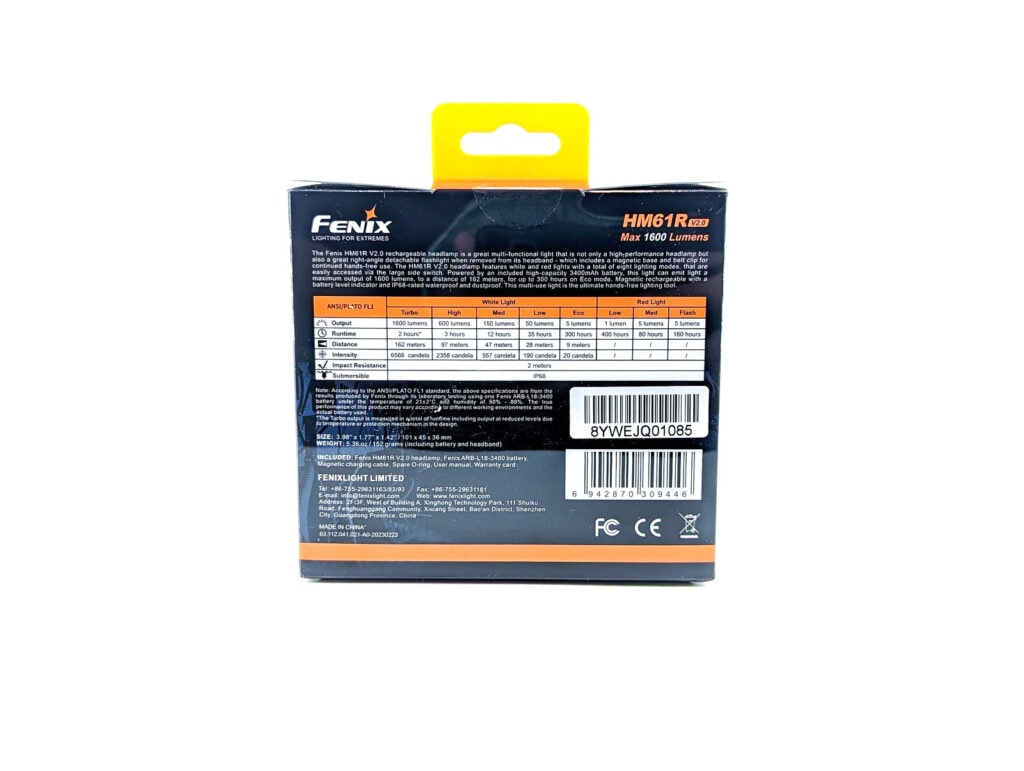
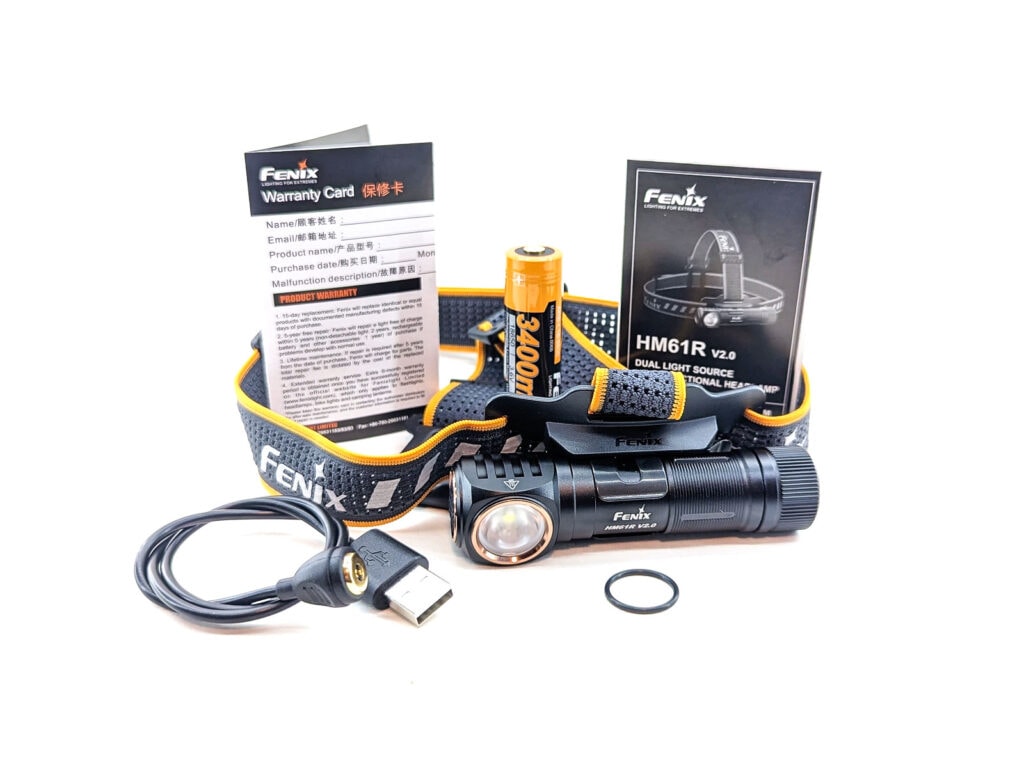
Flashlight in use
There are a few different primary body designs for headlamps, with the two main ones being L-shaped (right angle) and T-shaped. L-shaped lights can be pretty nice since they do dual-duty as both a headlight as well as a handheld or utility light. But as a dedicated headlamp, many people don’t like the L-shaped as the light is offset to the side and can feel a bit unnatural, especially for up-close tasks. The HM60R that I recently reviewed was of the T-shaped variety, with the emitters nearly centered in the body of the headlamp. That’s one of the most easily noticeable differences with the HM61R V2.0, which is an L-shaped light.
The Fenix HM61R V2.0 comes with the headband pre-installed. It’s pretty easy to remove the headlamp from the strap. The light is held to the strap by sliding the sturdy pocket clip into a slot on the plastic bracket of the strap. It’s an interesting setup, and quite handy as it makes going from headlight duty to worklight / flashlight duty a breeze.
The strap itself is pretty nice. It’s the additional strap that goes over the head and helps with stability. The straps connect to a wide plastic bracket that keeps it from putting too much pressure on your forehead from the bracket. The strap has a few sections of rubberized grip on the inside which can help keep the strap from sliding around, particularly on hats and helmets. Overall, the Fenix HM61R V2.0 is comfortable to wear.
The tailcap of the Fenix HM61R V2.0 is magnetic, which is a good feature to have if you’re going to remove the light from the head strap and use it as a work light. The magnet is helpful for positioning it on all kinds of ferrous surfaces, such as an appliance, a vehicle, or a workbench.
A headlamp such as this Fenix is great for all kinds of things: working around the house/garage/yard, hiking in the evening, hunting/fishing, etc. If I’m going to be working on something with my hands up-close (eg, electric work when you’ve got the circuit breaker off), then an L-shaped headlamp such as the HM61R V2.0 isn’t necessarily my first choice since the LED is set off to the side. The red LED is good for short-range things at night while trying to preserve your night vision like exploring your pack in the dark, reading a map, or navigating around your tent.
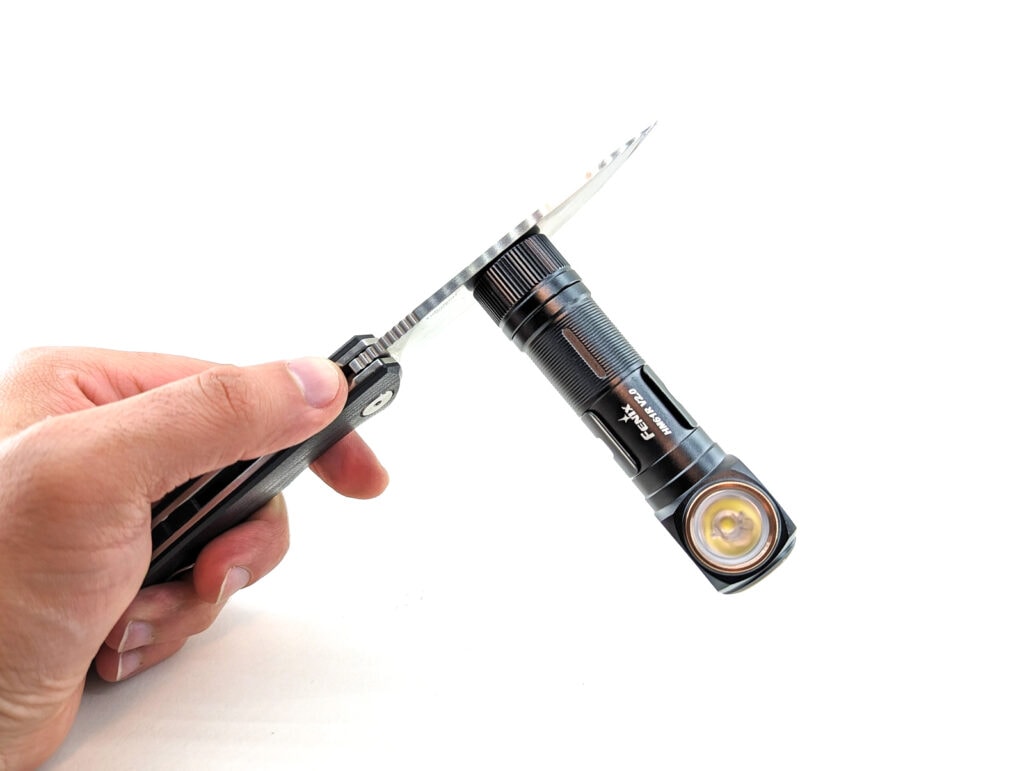
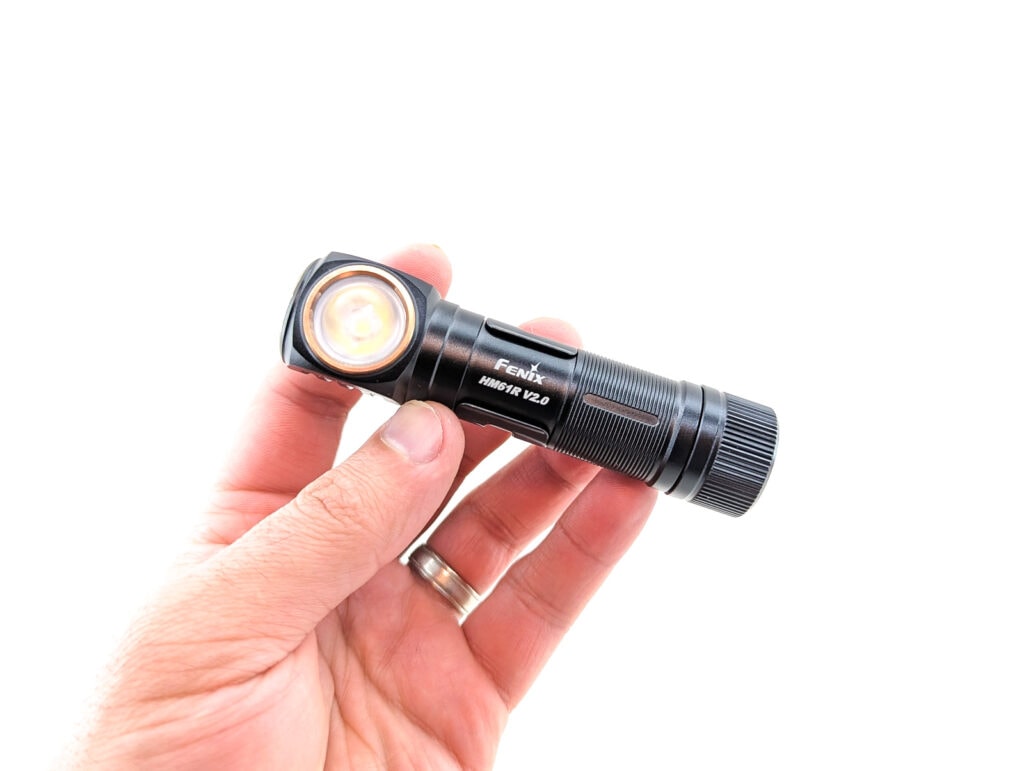

Build Quality and Warranty
Fenix used A6061-T6 aluminum in the construction of the HM61R V2.0, then coated it in premium type III hard anodizing. The fit and finish look absolutely great, as I’ve come to expect from Fenix. There’s no knurling to speak of. There are tiny grooves machined into the battery tube but they don’t provide much grip.
Warranty:
- 15 days from date of purchase: replacement from Fenix for manufacturing defects
- 5 year from date of purchase: free repairs
- Lifetime maintenance, with customer covering the cost of parts
- Extra 6 month warranty period for products registered on Fenix’s website
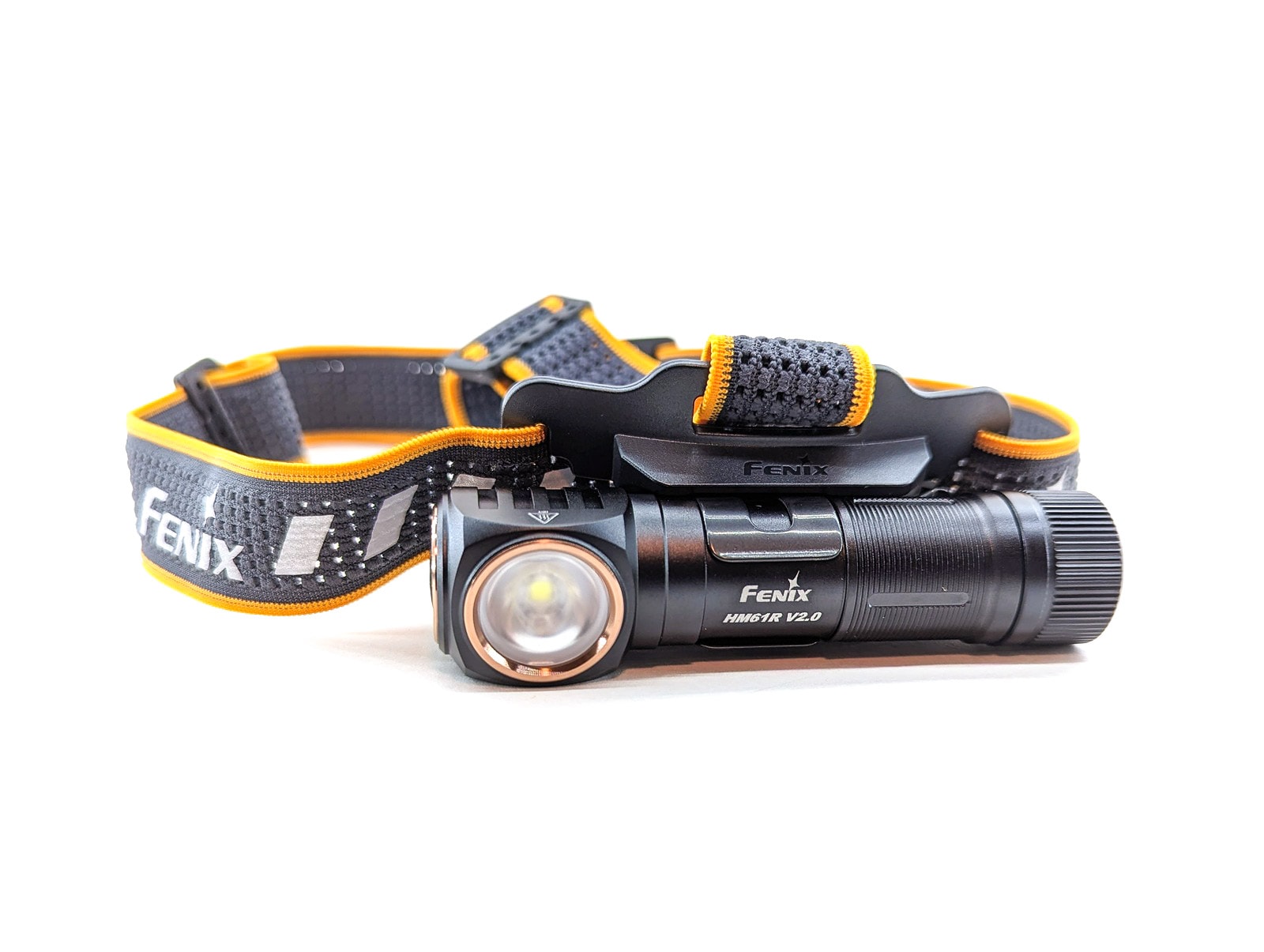
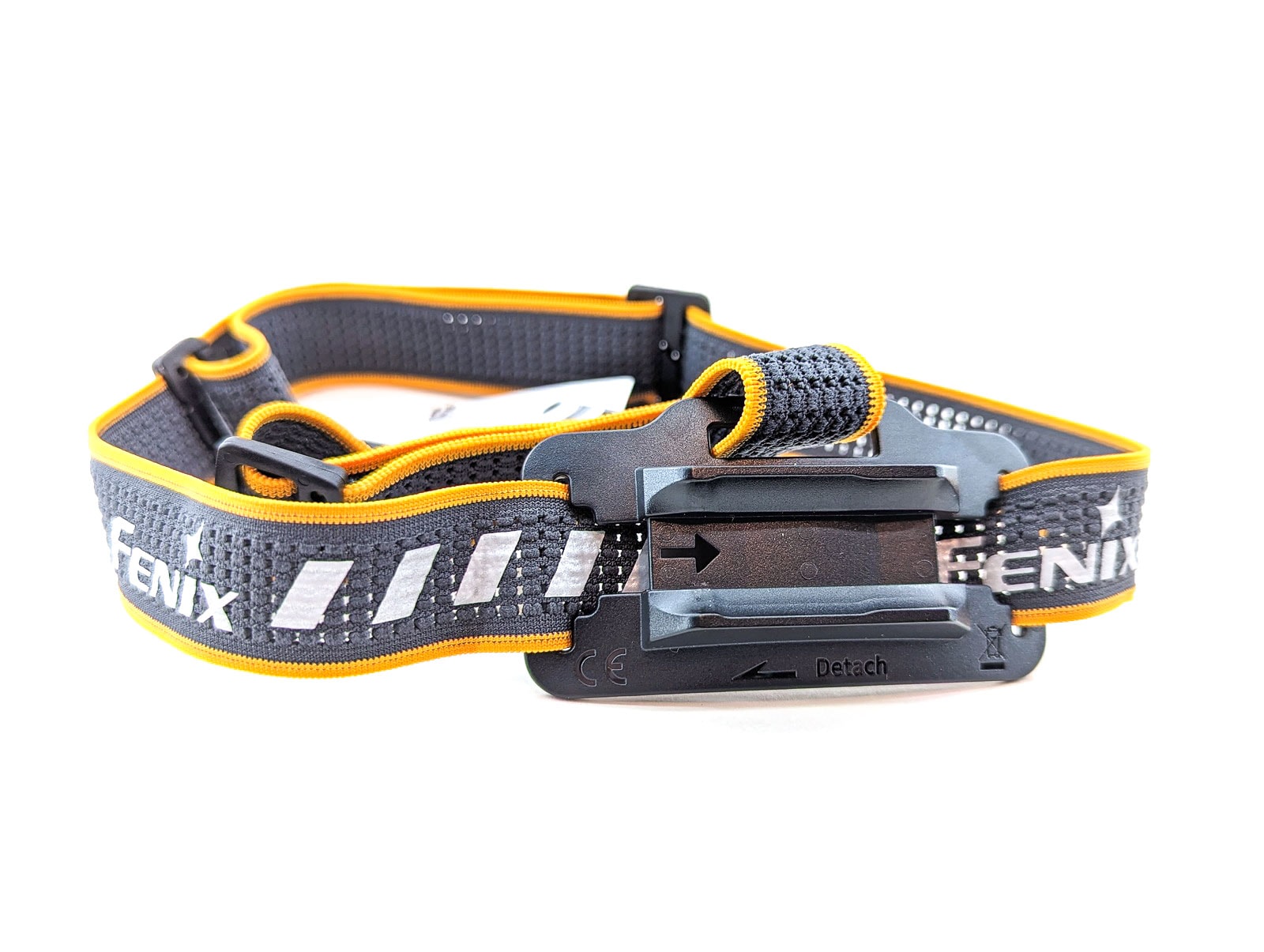
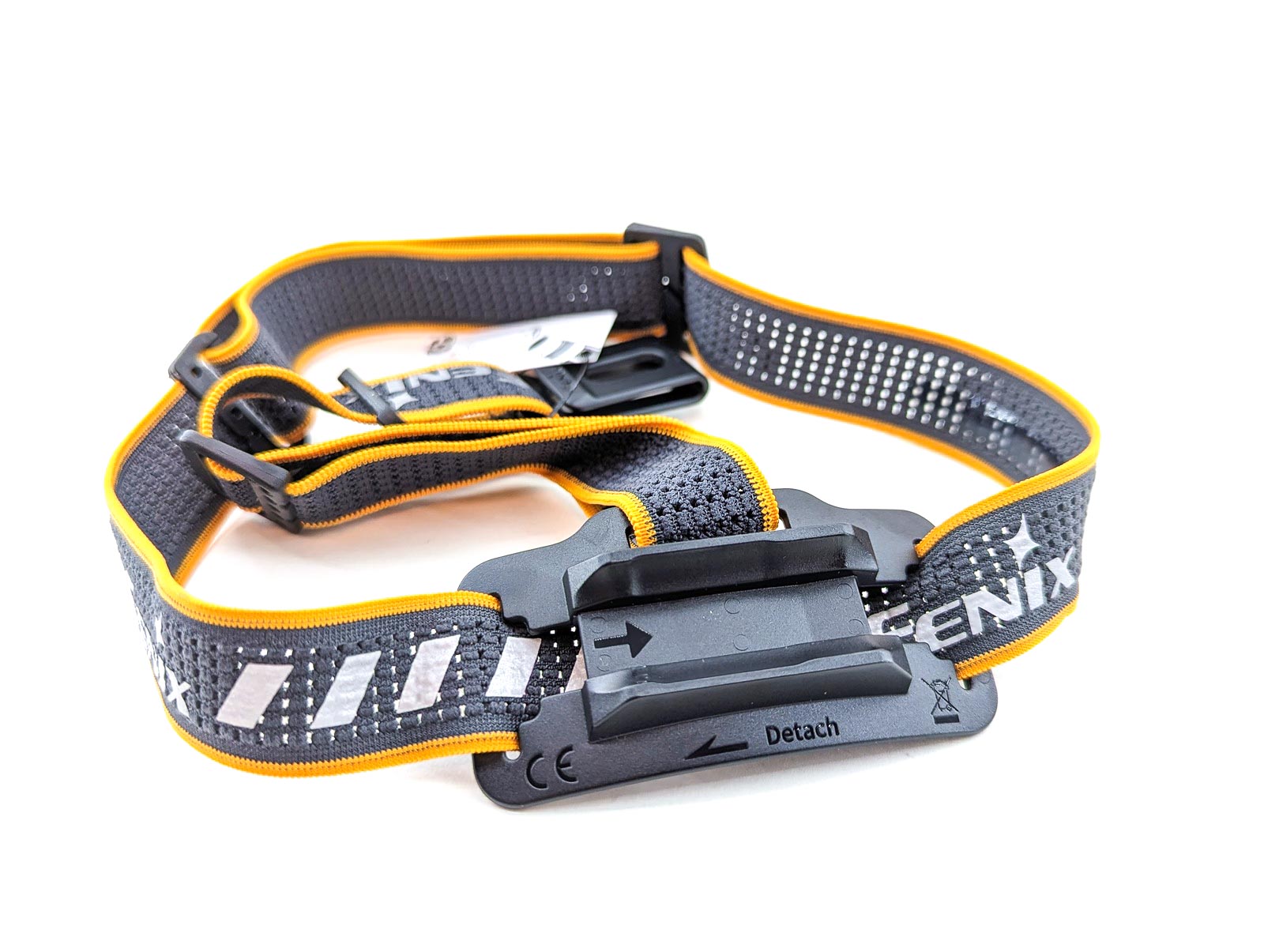
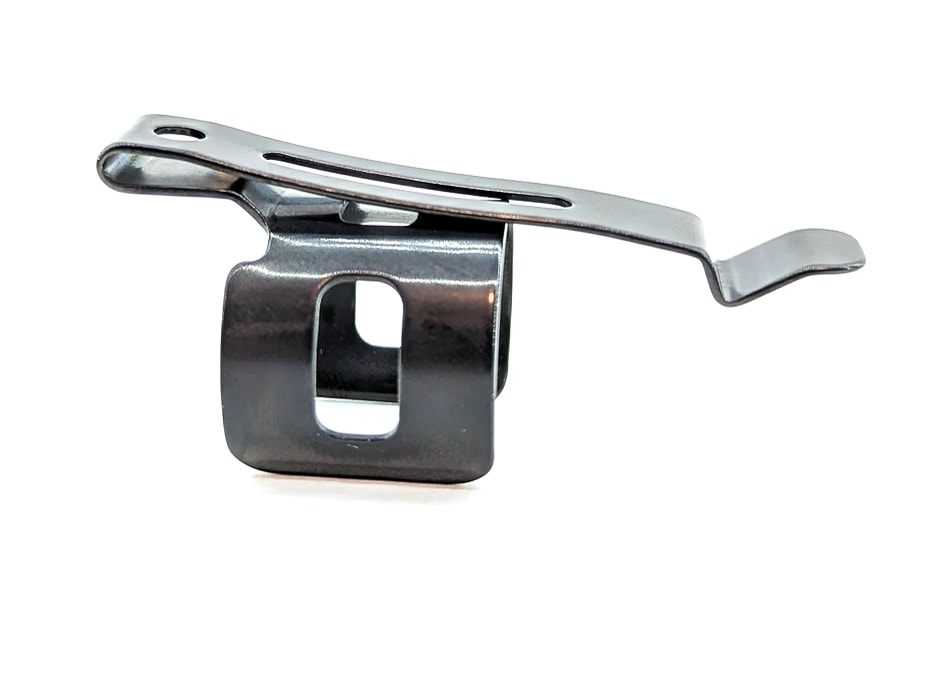
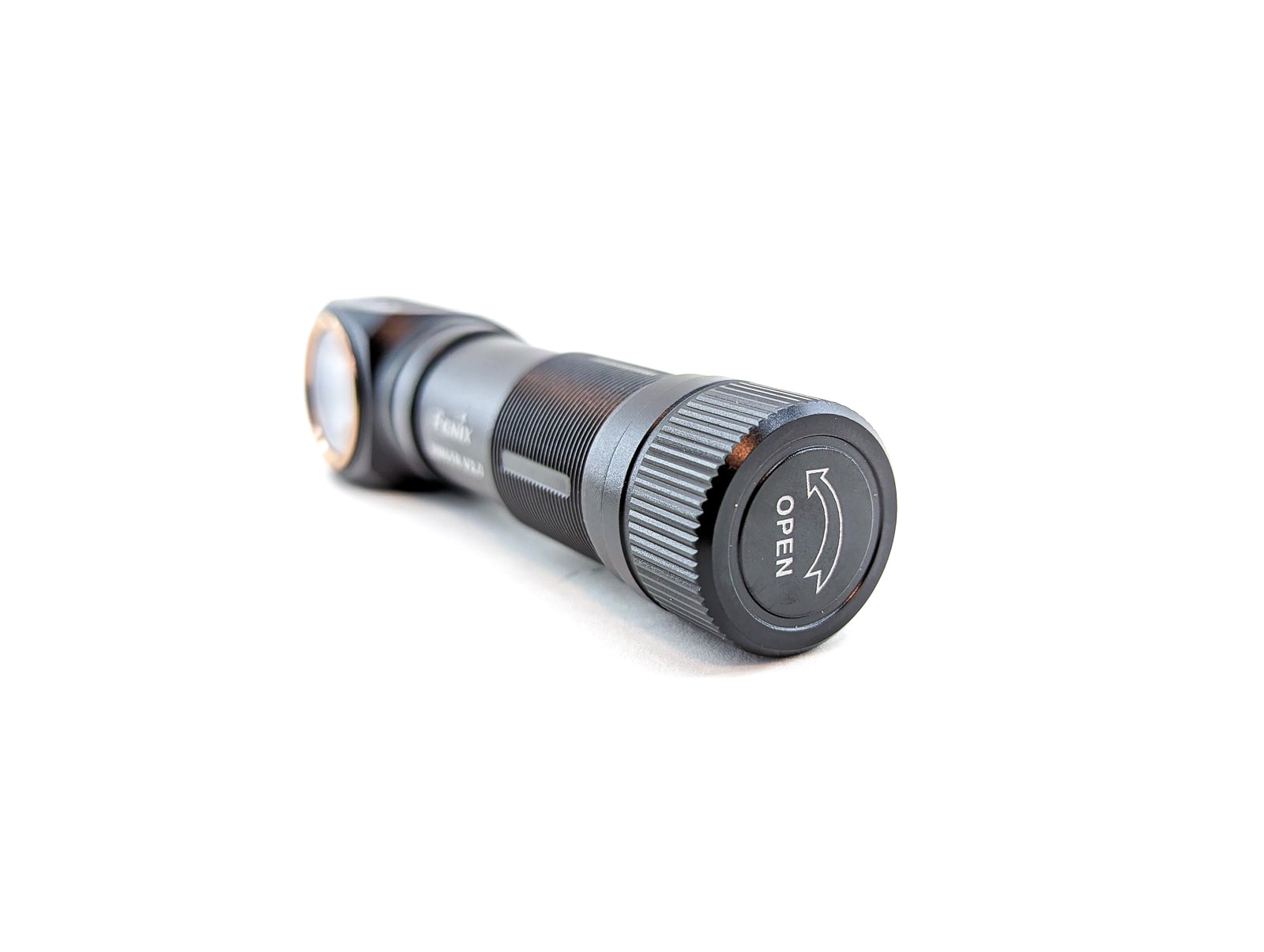
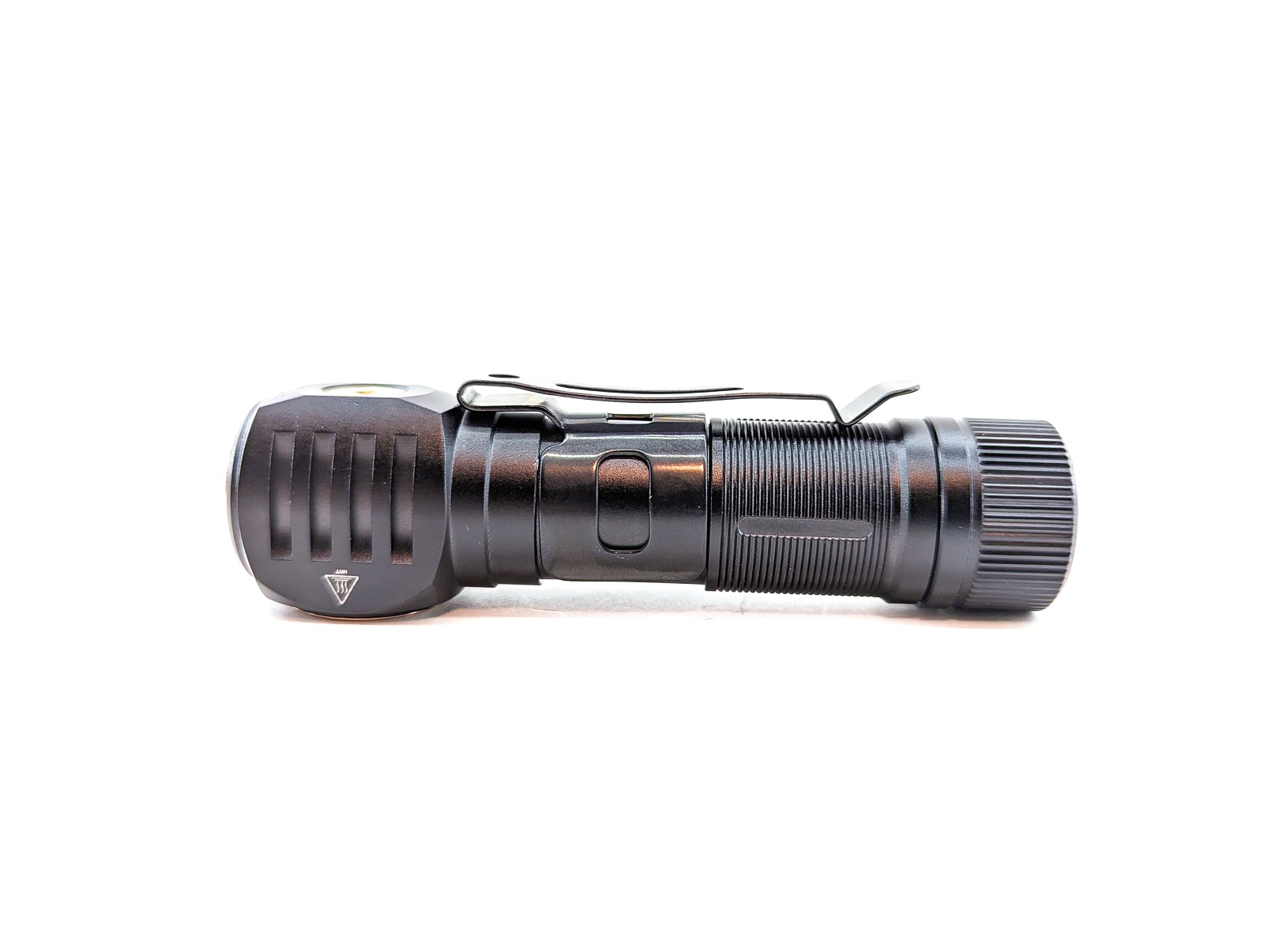
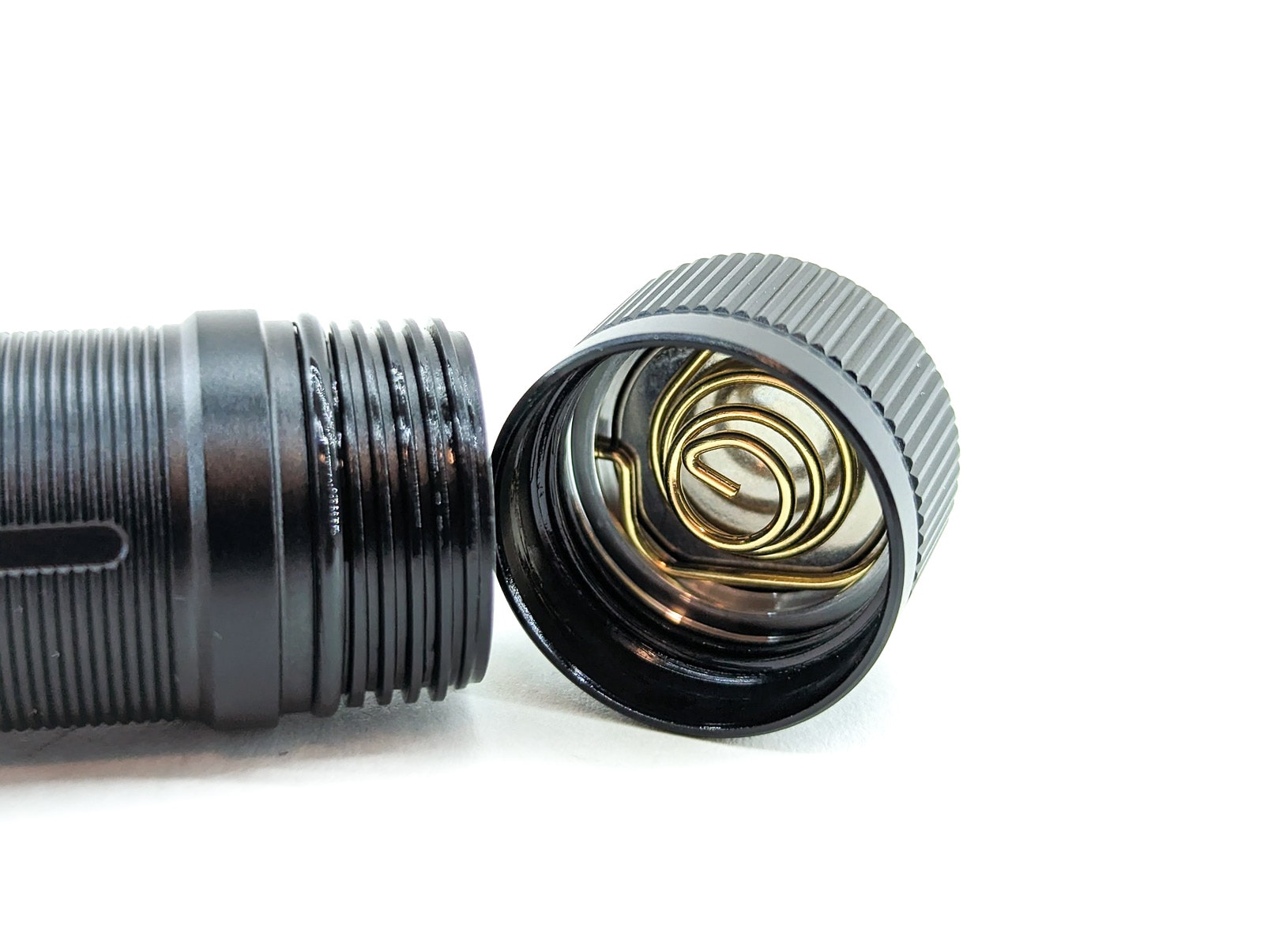
LED, Lens, Bezel, Beam, and Reflector
Fenix went with a Luminus SST40 LED for the HM61R V2.0. This LED has been around for a few years now and has made appearances in flashlights of all shapes and sizes. It’s a 5050 footprint LED that I’ve only ever seen available in 70-CRI and neutral-to-cool CCTs. While many may not consider the light to be “high quality” (ie, high CRI), it is fairly efficient. The LED is nicely centered in a frosted TIR optic. The optic produces a very smooth transition from hotspot to wide spill.
While you can’t really tell by looking at the optic, discreetly placed on the sides of the SST40 are a pair of 2835 red LEDs (two red LEDs total). That’s really about all there is to know about the red LEDs: they’re there and they work fine. I do appreciate that Fenix gave the red channel two brightness levels. All too often it seems like red channels have only one output level.
I got the following measurements of the center of the beam with my Opple Light Master at 3 meters with the Fenix being on Turbo:
- CCT: 5555K
- CRI: 65.2 Ra
- DUV: +0.0089
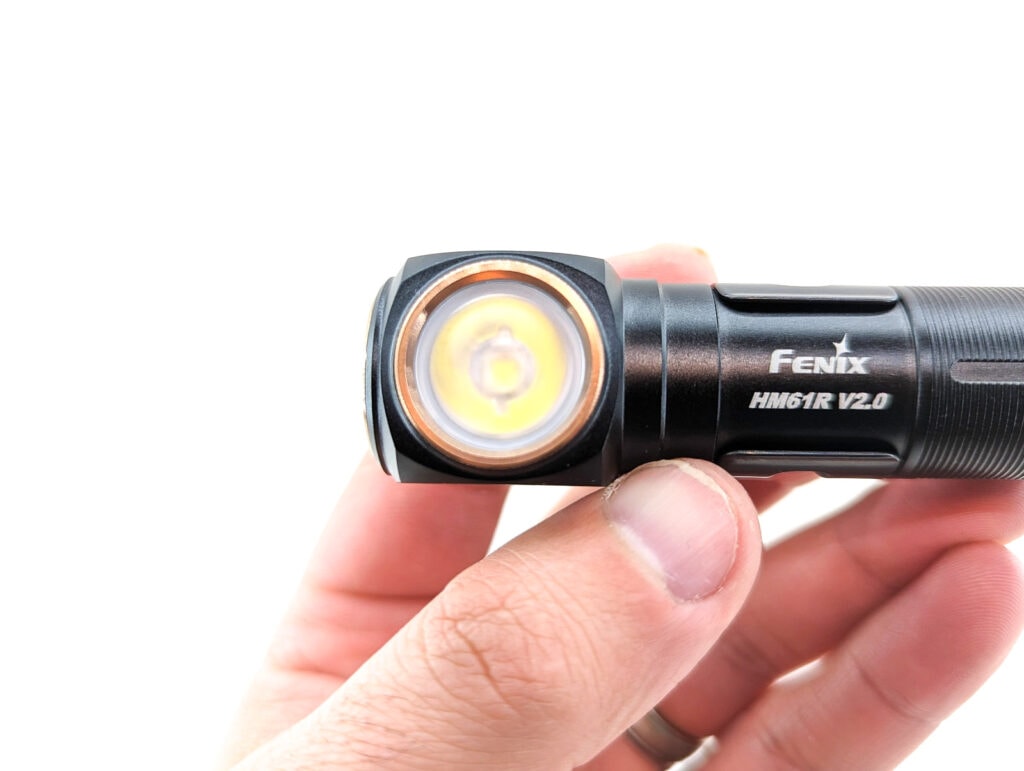
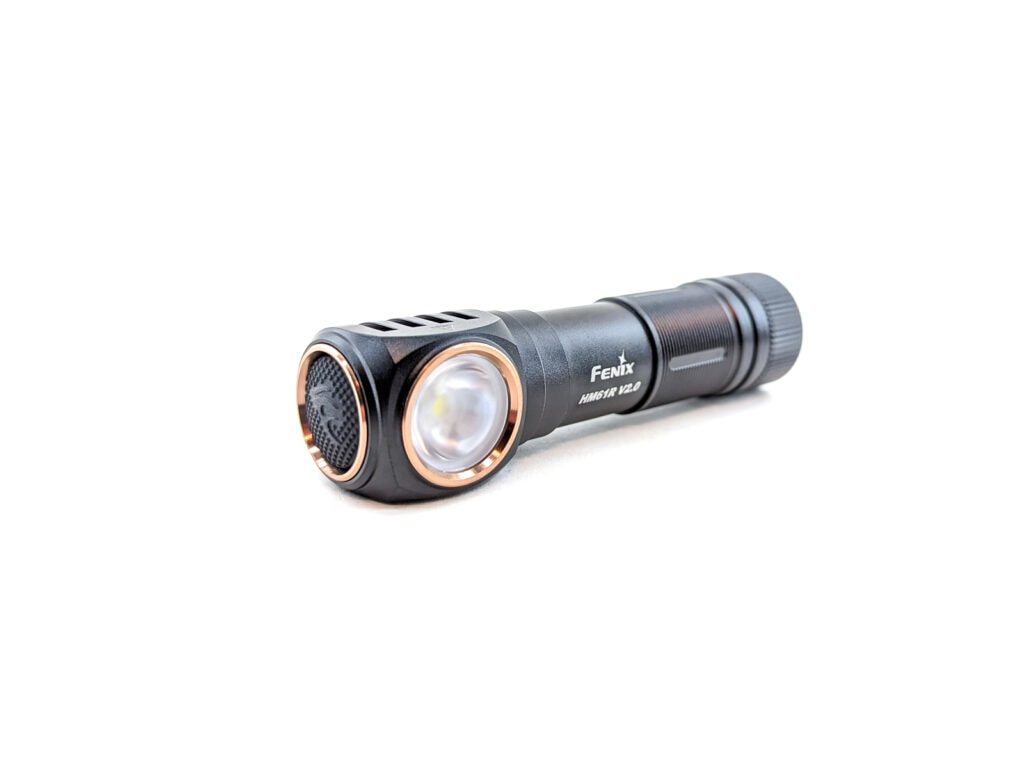
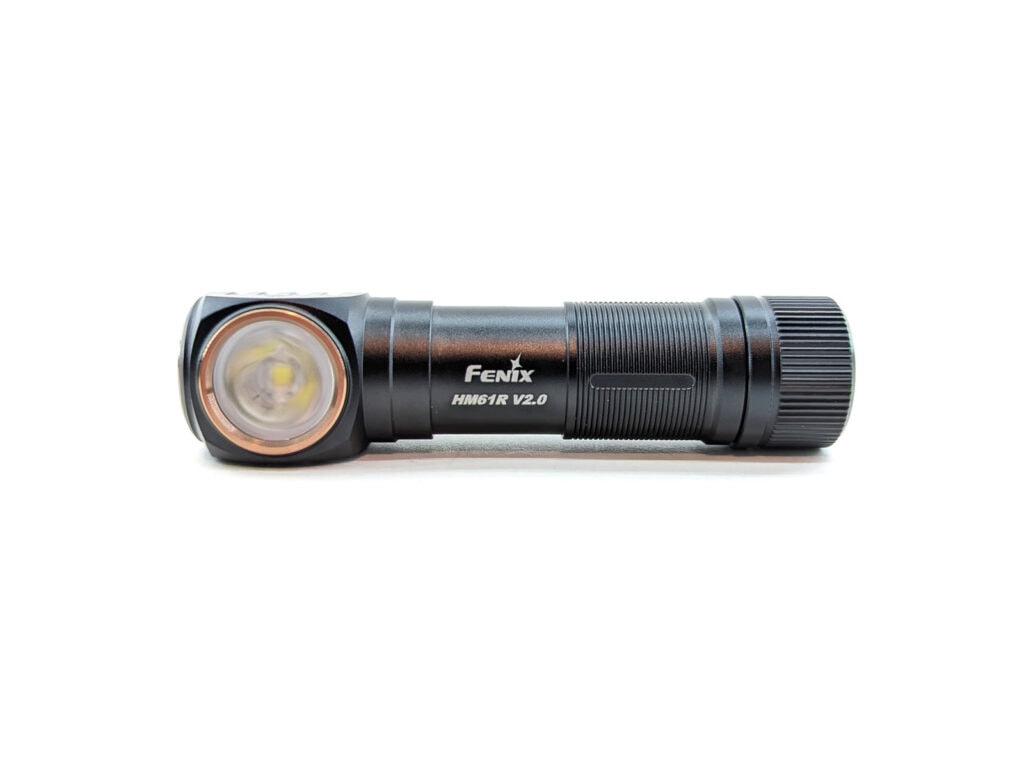
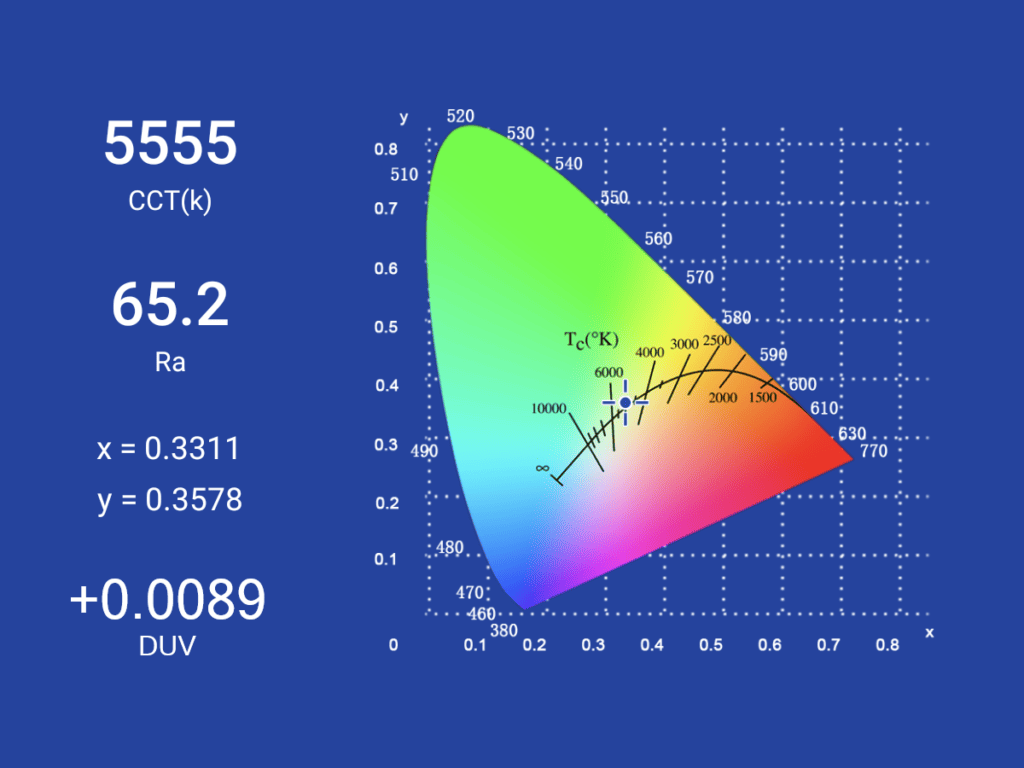
Dimensions and its competition
| Fenix HM61R V2.0 | Millimeters | Inches |
|---|---|---|
| Length | 101 mm | 4.0 in |
| Head diameter | 27 mm | 1.1 in |
| Body diameter | 20 mm | 0.8 in |
Dimensions are rounded to the nearest millimeter, and to the nearest tenth of an Inch.
Weight:
| Fenix HM61R V2.0 | Weight in grams | Weight in oz |
|---|---|---|
| Without battery: | 58 g | 2.0 oz |
| With battery | 108 g | 3.8 oz |
| With battery and headband | 152 g | 5.4 oz |
Weight is rounded to the nearest gram, and to the nearest tenth of an Oz.
Flashlight size comparison with its competition headlamps:
Compared to some of the best headlamps
Group 1: Fenix HM61R V2.0, Fenix HM60R
Group 2: Fenix HM61R V2.0, Wurkkos HD15
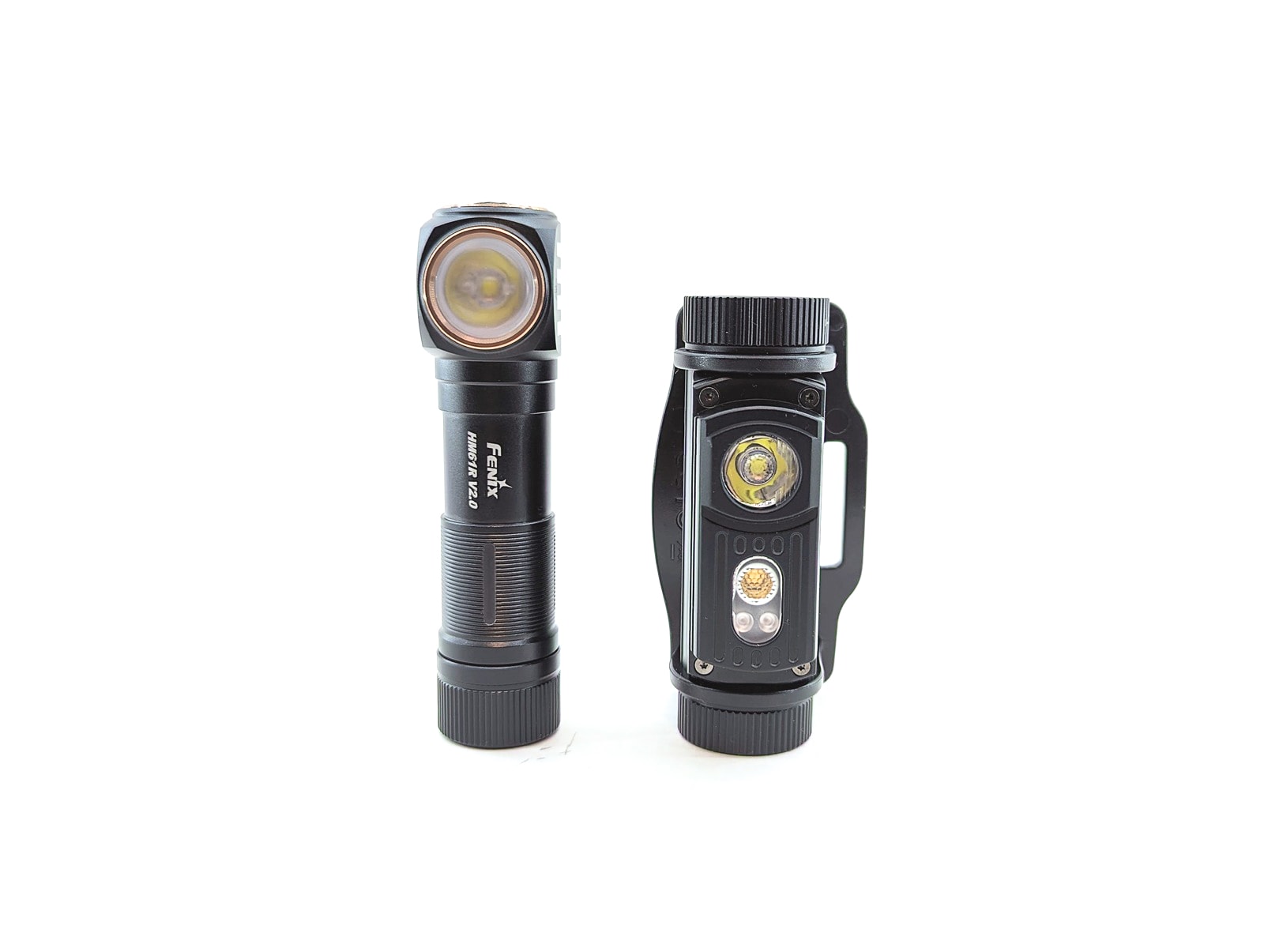
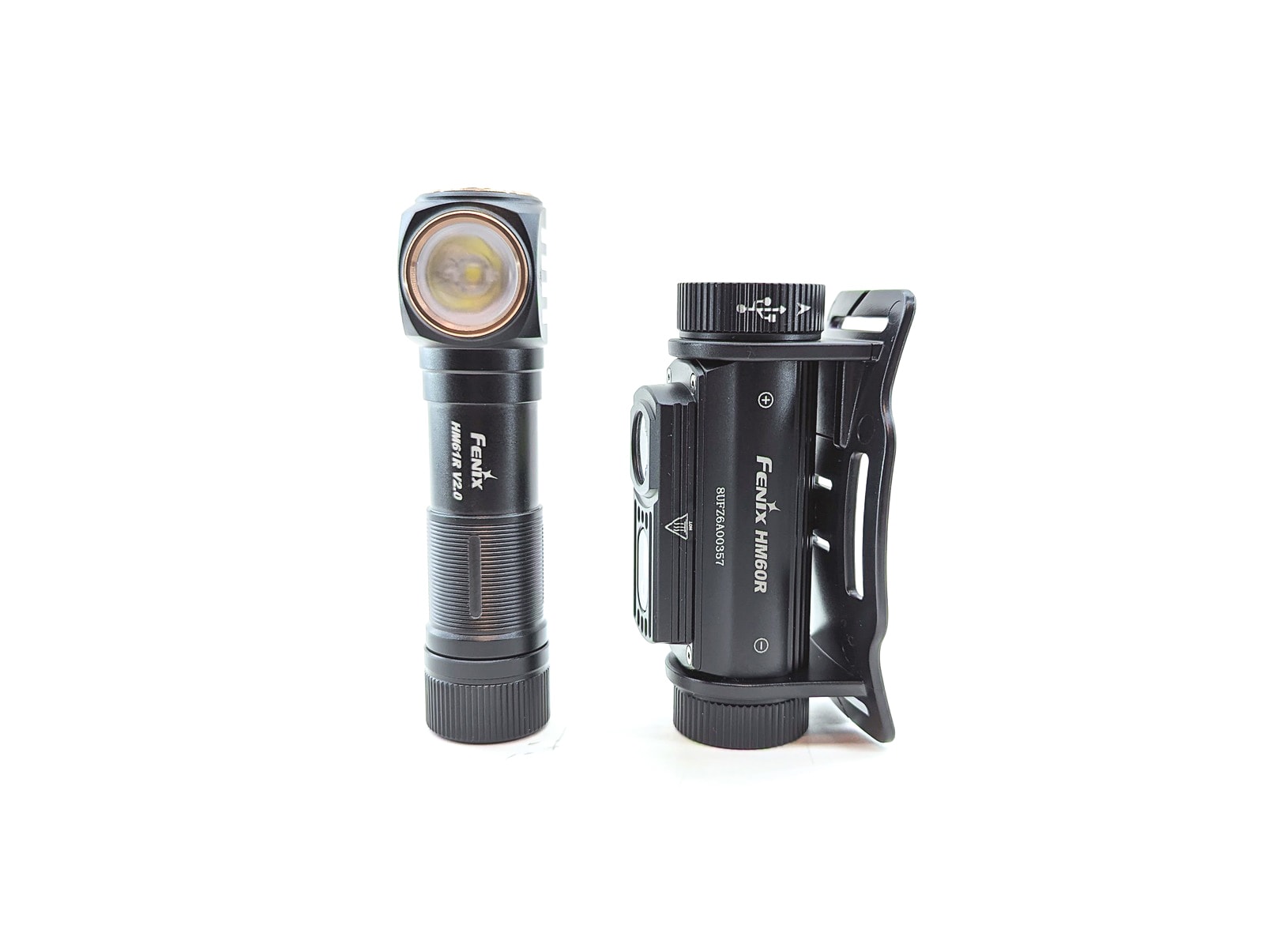
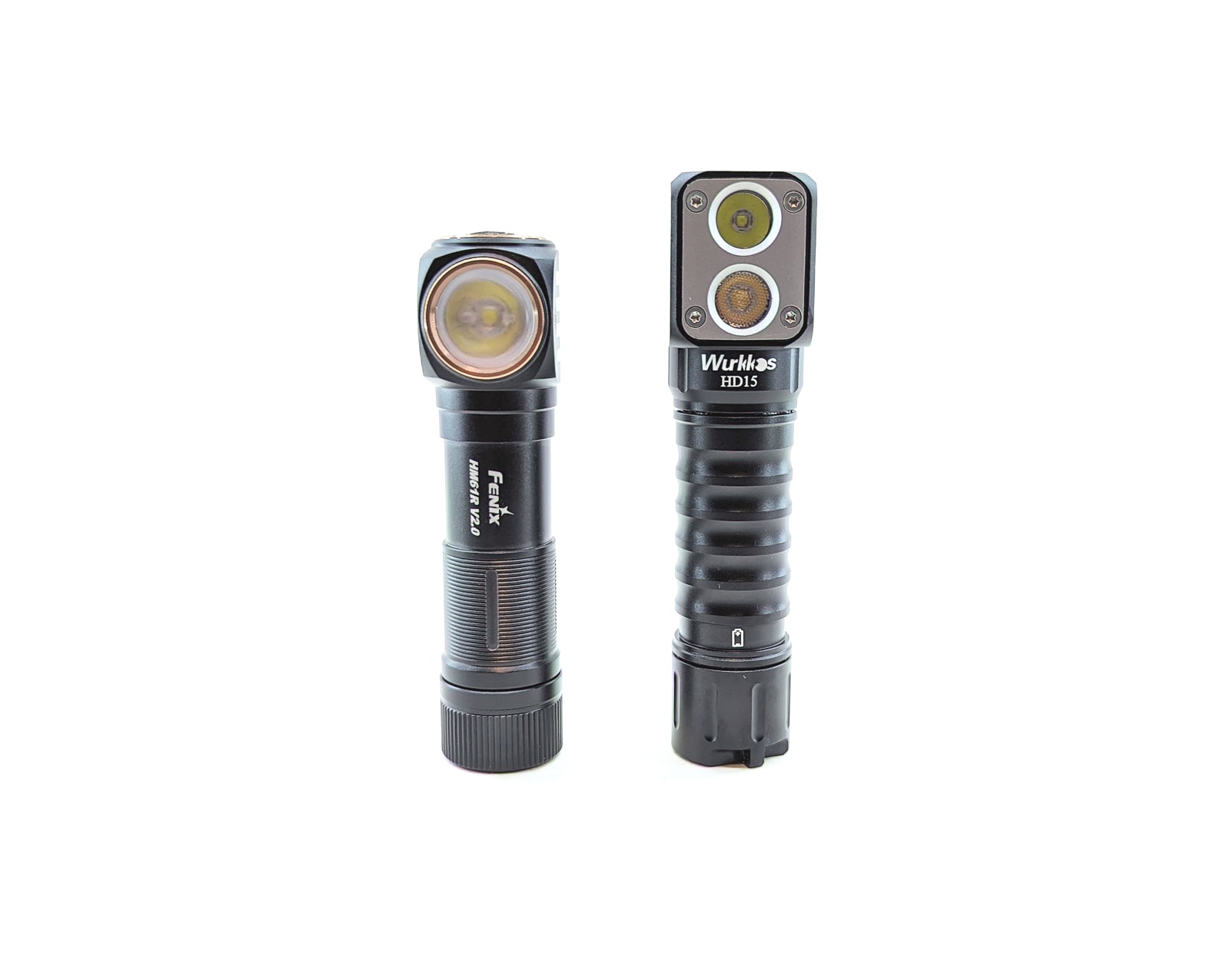
Fenix HM61R V2.0 UI: User Interface and Driver
The UI that Fenix uses on their single-switch lights isn’t my personal favorite, but at least I think it’s pretty consistent. In short, it’s a short-hold for On and Off. I think that’s because it should be more difficult to accidentally activate in your pocket that way. The UI of the HM61R V2.0 differs slightly, though, to accommodate the Red Mode switching.
Available modes:
- Red Low, Red Med, (White) Eco, Low, Med, High, Turbo
Available blinky modes:
- Red Flash (like a beacon or distress signal)
From OFF:
- Press and Hold 0.5 sec: turn on in White mode (last used brightness)
- Press and Hold 3 sec: Lockout
- Double click: Red Low
From ON:
- Press and Hold 0.5 sec: turn off
- Press and Hold 1.2 sec: switch between red and white modes
- 1 click: change brightness
- In White mode: Eco > Low > Med > High > Turbo
- In Red mode: Red Low > Red Med > Red Flash
Mode memory:
- Yes, it has mode memory in white mode
- When turning the light off in Turbo, it will revert to High mode
- The red mode always comes on in Red Low (no memory for red)
Shortcuts:
- To Red Low: double click from Off
Low voltage warning/protection:
- When the battery voltage gets low, output will step down
- There is a battery indicator LED under the switch that activates for 3 seconds when you single-click the button while the light is off:
- Green solid: 100-85%
- Green flashing: 85-50%
- Red solid: 50-25%
- Red flashing: 25-1%
Strobe/blinkies
- Red Flash: double click from Off to get into Red mode, then click twice to navigate to Red Flash
Lock-out mode:
- Hold the button for 3 seconds from Off to lock
- Pressing the button while locked out will generate 4 red blinks
- Hold the button for 3 seconds to unlock the light
PWM
- No PWM was detected
Fenix HM61R V2.0 Charging and batteries
The Fenix HM61R V2.0 comes with a Fenix-branded cell, the Fenix ARB-L18-3400. It is not a proprietary battery, just a button-top 3400 mAh 18650 battery with a protection circuit. I tried flat-top Samsung 30Q and 35E batteries; they were too short to make contact. I also tried a button-top (non-protected) Sofirn 18650 and it made inconsistent contact – not very usable. So it looks like a protected battery is required, others will be too short.
The Fenix HM61R V2.0 has a magnetic charging port on the side of the head. A magnetic charging port makes me feel pretty good about water and dust resistance, but I feel that they’re not quite as convenient as their USB-C port counterparts. I have USB-C chargers everywhere. I have this magnetic Fenix cable at exactly one location. As long as you’re mindful of that and take the charging cable with you anytime you think you might need to top up the battery, you should be just fine.
Fenix says that a fully depleted battery should take 4 hours to recharge. While charging, the indicator LED will illuminate red, then switch to green when charging is complete. In my testing, I observed a 6.01 watt charge rate (1.16A at 5.17V) and the cycle completed in 3 hours 16 minutes, stopping at 4.17 volts. While the light is charging, you can use any mode except for High and Turbo.
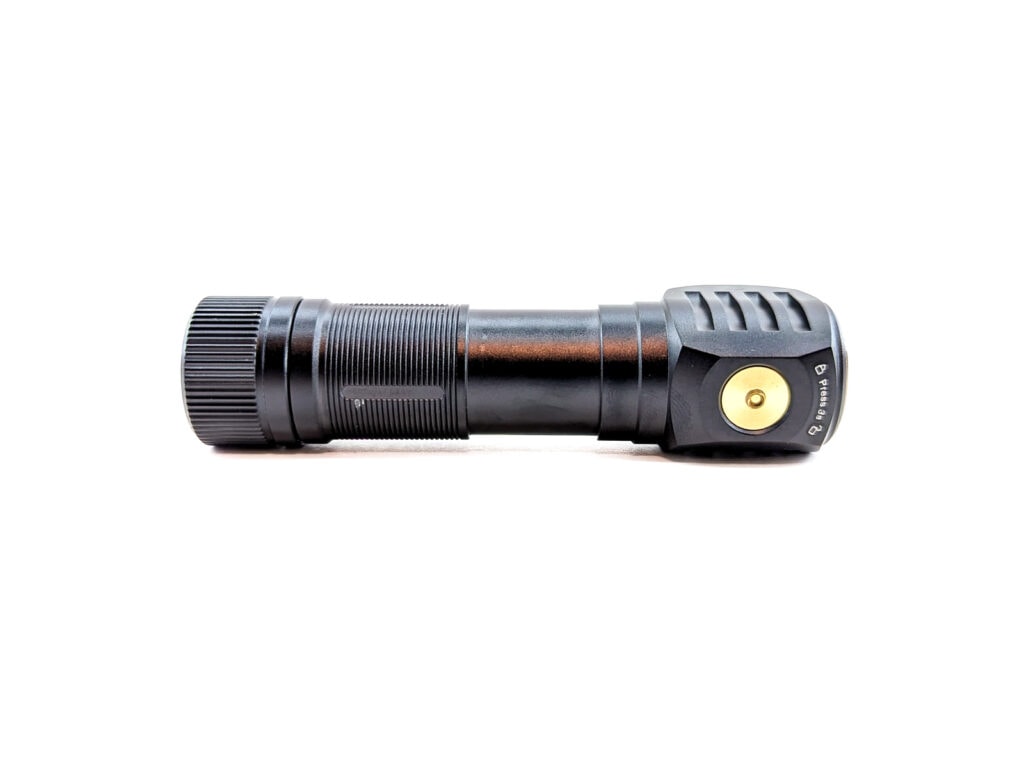
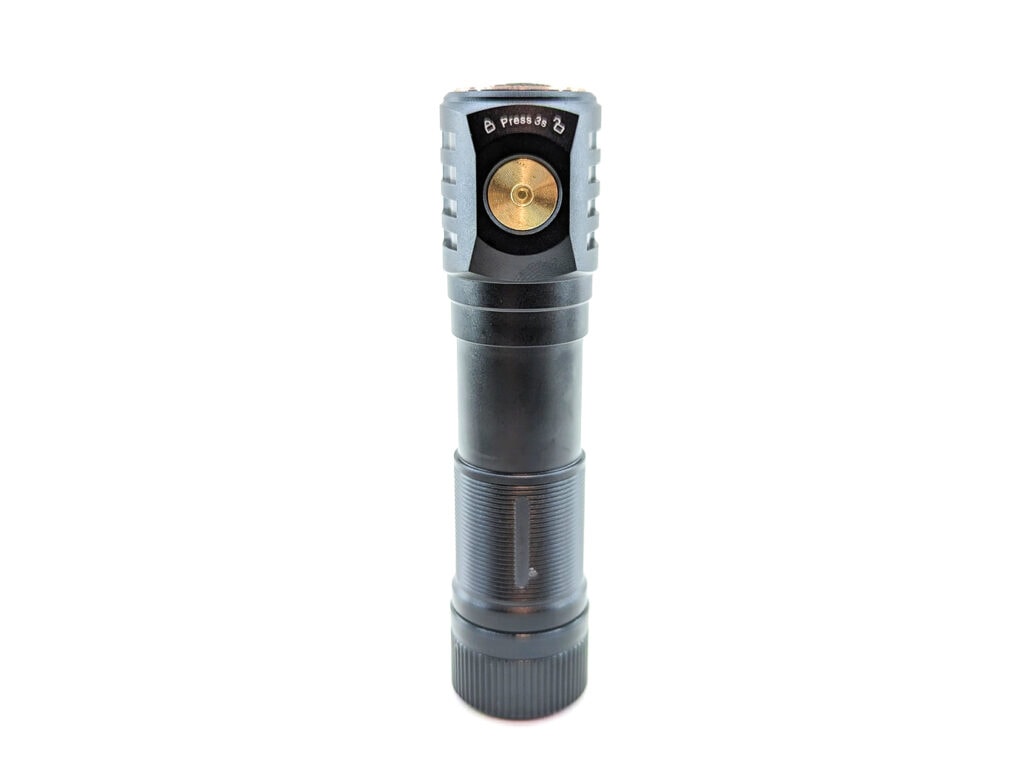
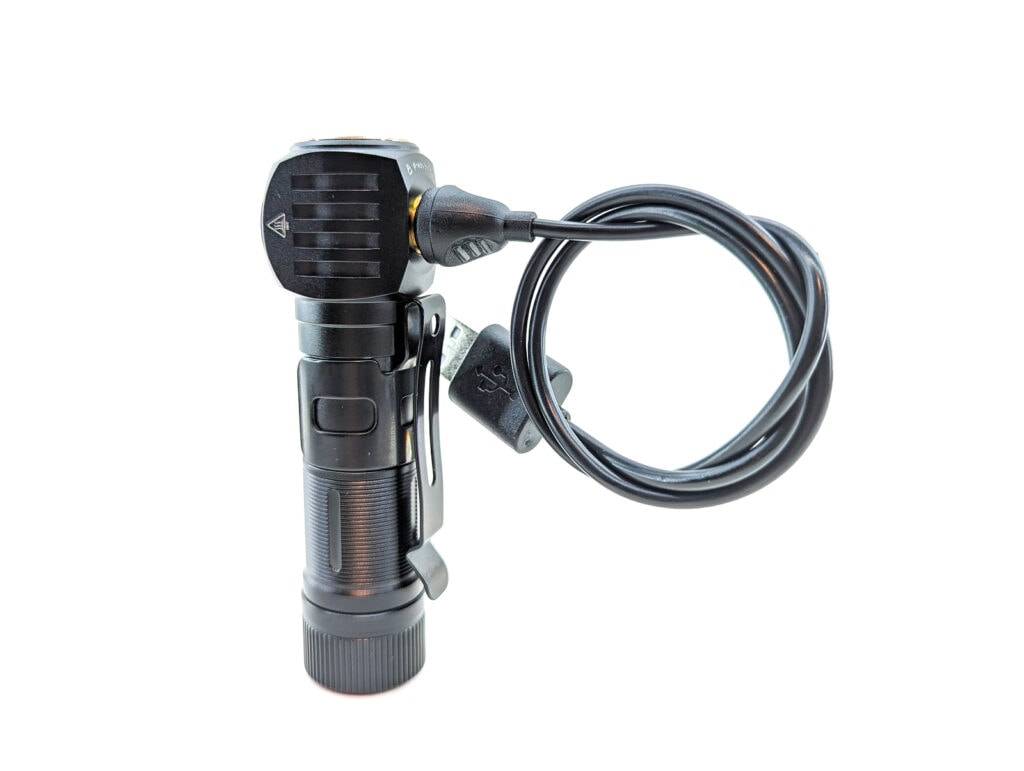
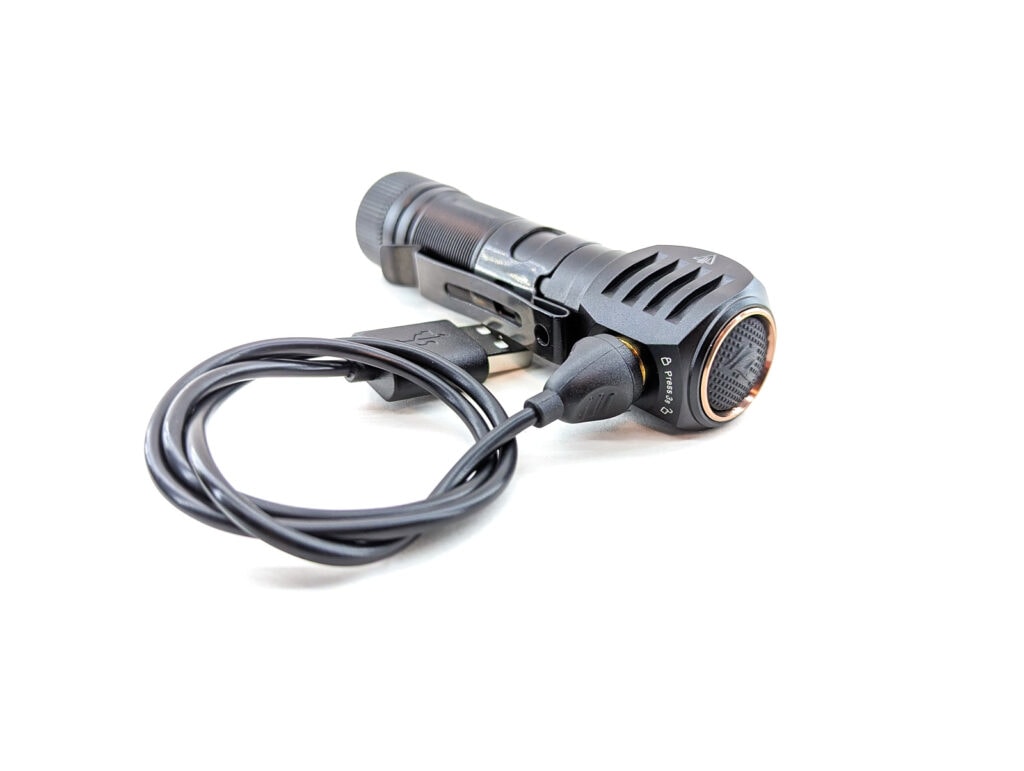
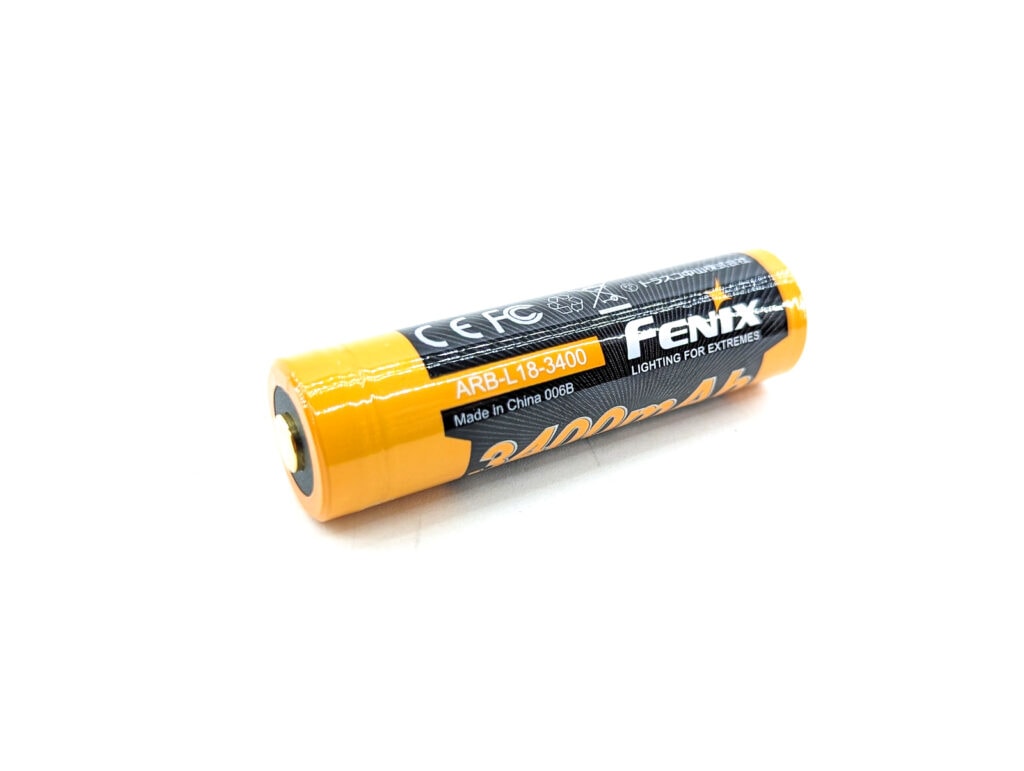
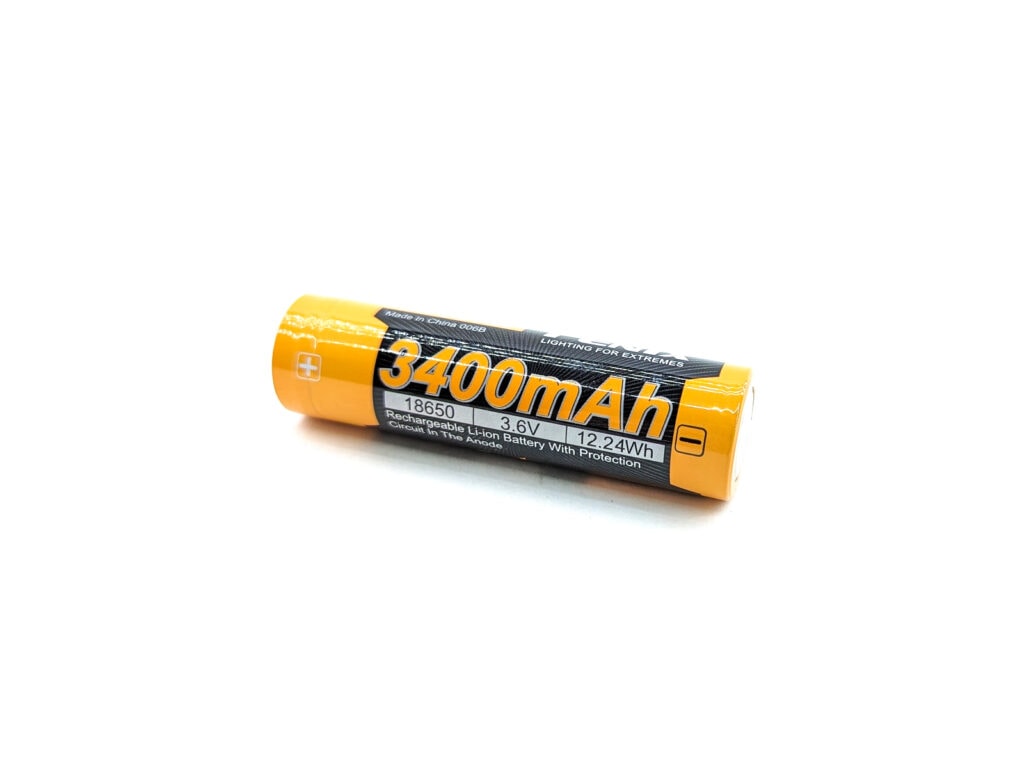
Performance test
Lumen measurements
How Lumens are Measured: Understanding ANSI FL1 Standards How Lumens are Measured: Understanding ANSI FL1 Standards: The ANSI FL1 standards specify that output in lumens should be measured 30 seconds after turning on, as this is the standardized time for measuring brightness according to the industry standard. This is why we focus on this part in our measurements. The ANSI FL1 standards require an ambient temperature of 22 ± 3°C. We record the ambient the ambient temperature to identify potential reasons for any observed discrepancies.Lux was measured by a UNI-T UT383 BT at 5 meters. Lumens were measured in a homemade lumen tube using a VEML7700 sensor, calibrated with a calibration light provided by 1Lumen. The included Fenix battery was used for testing.
| Mode | Amps at start | Specs | turn on | 30 sec | 10 minutes |
|---|---|---|---|---|---|
| Eco | 10 mA | 5 lm | 4.5 lm | 4.5 lm | – |
| Low | 80 mA | 50 lm | 43 lm | 43 lm | – |
| Med | 239 mA | 150 lm | 114 lm | 114 lm | 114 lm |
| High | 1.1 A | 600 lm | 607 lm | 608 lm | 590 lm |
| Turbo | 4.4 A | 1600 lm | 1617 lm | 1510 lm | 573 lm |
| Turbo at 3.6V | – | – | 1256 lm | 1179 lm | – |
| Red Low | 12 mA | 1 lm | 0.7 lm | 0.7 lm | – |
| Red Med | 47 mA | 5 lm | 2.8 lm | 2.8 lm | – |
Parasitic drain:
- 12 µA
In general, I would say that my results line up closely with Fenix’s claims. However, my 30 second reading in Turbo is slightly lower than spec, but it’s within 6% which could honestly be light-to-light or LED-to-LED variability, or limitations of the accuracy of my homemade measuring setup. Everything else is pretty much in line with specs. Do note that while I have lumen measurements shown for the red modes, I do not know how accurate my setup is for measuring red light.
Fenix HM61R V2.0 Battery Life: Runtime graphs
How Runtimes are Measured: Understanding ANSI FL1 Standards About ANSI FL1 runtime standards: The runtime is measured until the light drops to 10% of its initial output (30 seconds after turning on). This does not mean that the flashlight is not usable anymore. The last column shows how long the light actually works till it shuts off. If there is a + symbol, it means that the test was stopped at that particular point, but the light was actually still running. This happens on certain occasions, with certain drivers, firmware, or batteries.| Mode | Specified | Measured runtime ANSI | Time till shut off |
|---|---|---|---|
| Eco | 300h | – | – |
| Low | 35h | – | – |
| Med | 12h | 12h 7min | 25h 4min+ |
| High | 3h | 3h 3min | 10h 55min+ |
| Turbo | 2h | 2h 44min | 3h 4min+ |
| Red Low | 400h | – | – |
| Red Med | 80h | – | – |
The runtimes line up very closely to Fenix’s specs. The HM61R V2.0 kept on going for hours and hours at 4 lumens, so the output tests were eventually cut off.
I will say that both Turbo and High did a great job at keeping the temperature in-check, right around the 60°C limit. Unfortunately this came at the expense of some fairly rapid and large swing in output. I would have liked to have seen the thermal control algorithm dialed in a little bit better.
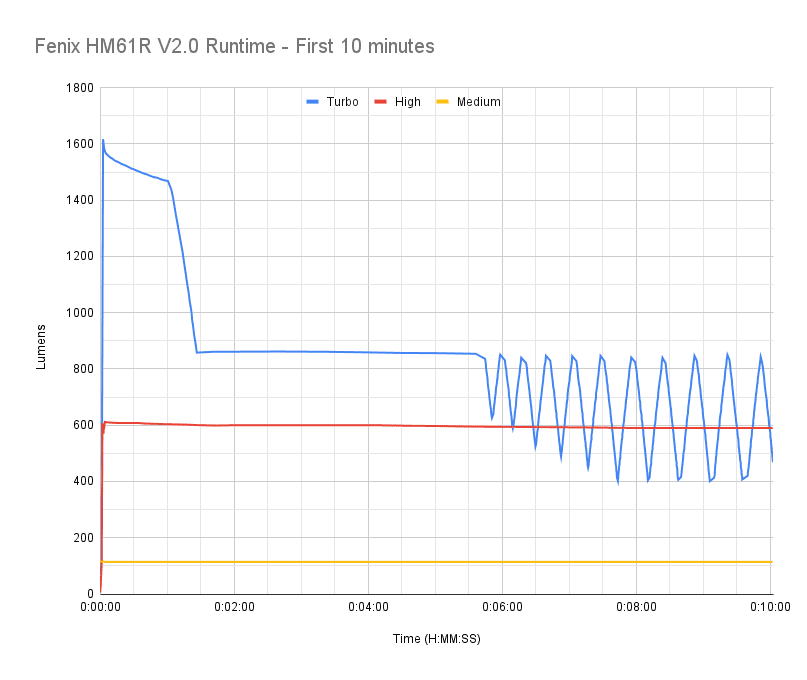
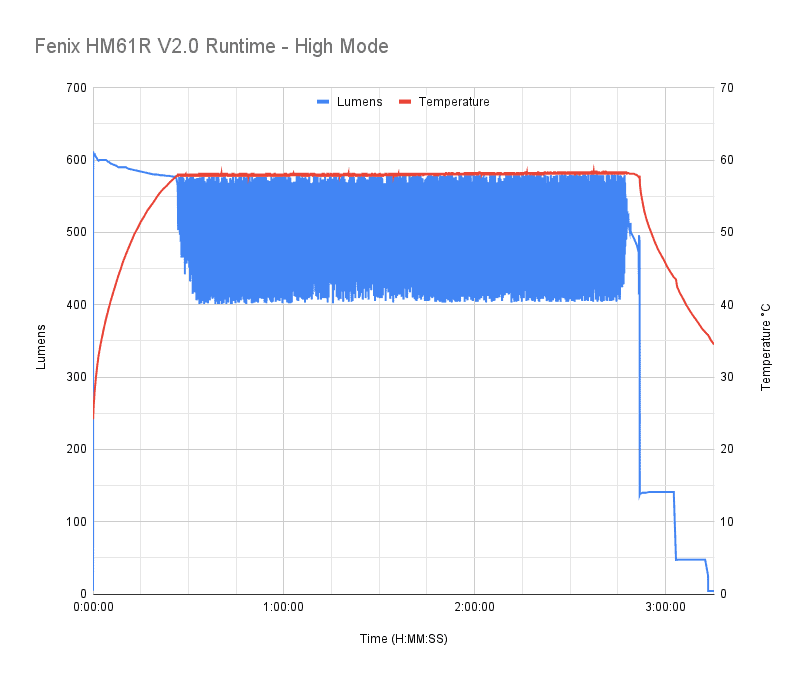
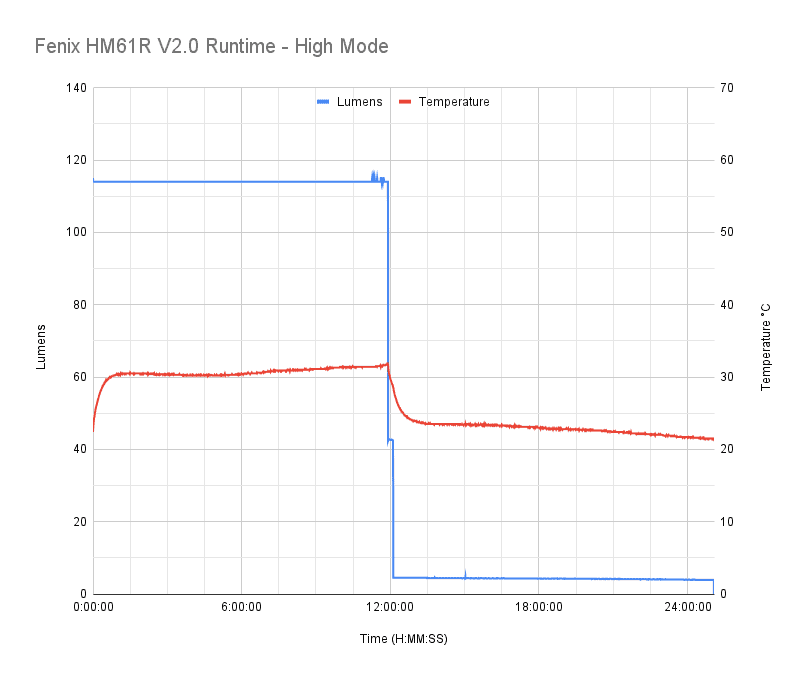
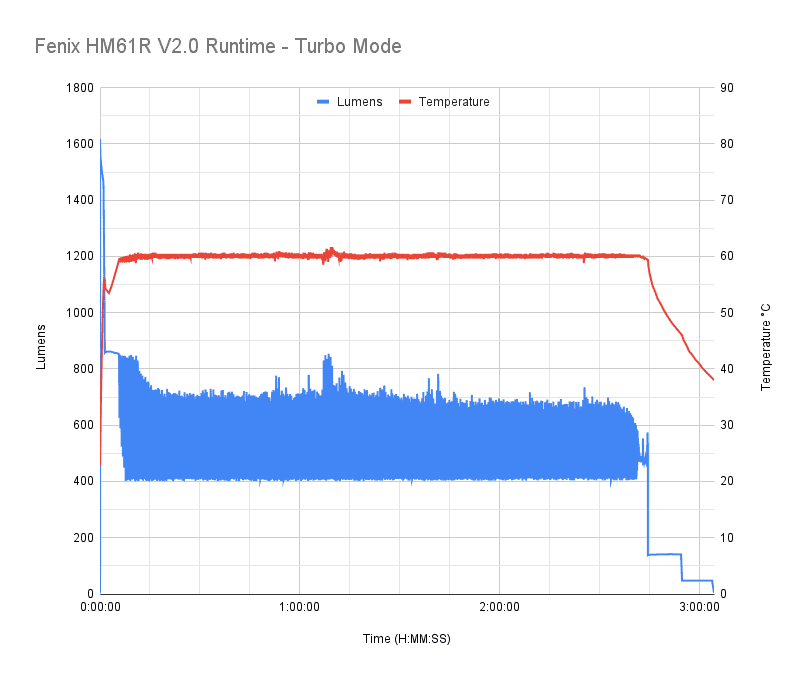
Peak beam intensity and beam distance measurements
About Peak beam intensity: Understanding ANSI FL1 Standards About peak beam intensity The calculated value of distance in meters at which the flashlight produces a light intensity of 0.25 lux. (0.25 lux is about the brightness of a full moon shining on an object). This means that the intensity has decreased so much, it becomes difficult to see darker objects, or objects that don’t reflect light. The columns ‘Meters’ and ‘Yards’ use rounded numbers.| Mode | Specs | Candela measured | Meters | Yards |
|---|---|---|---|---|
| Eco | 20 cd | 36 | 12 m | 13 yd |
| Low | 190 cd | 168 | 26 m | 28 yd |
| Medium | 557 cd | 468 | 43 m | 47 yd |
| High | 2,358 cd | 1,904 | 87 m | 95 yd |
| Turbo | 6,566 cd | 5,950 cd | 154 m | 169 yd |
Much like the lumen measurements, I saw numbers pretty close to Fenix’s claims, but just a little bit lower.
Beamshots
Camera settings and distance:
Beam shots of the building are taken at 30 m (33 yd) using a Pixel 7 set to ISO 800 with 1/10 second exposure time
Beamshots of the following headlamps compared:
- Fenix HM61R V2.0
- Fenix HM60R
- Sofirn HS40



Disclaimer: This flashlight was sent to me for review at no cost by Fenix Lighting US. I have not been paid to review, nor have I been holding back on problems or defects.
Final Verdict
Pros
- Great build quality
- White & red modes
- Magnetic charging
- Quickly change between headlight and worklight
Cons
- Thermal control swings
- No shortcuts for Eco or Turbo
- Slightly misses output specs
Explanation on star ratings:
1: Avoid: a match would be a better choice – 2: Poor: significant defect or issues; almost unusable – 3: Average: some defects or issues; but still usable 4: Good: recommended (minor issues) – 5: Great: highly recommended

4 stars: ★★★★
While our star rating provides a reliable indicator, we encourage you to read the full review to make an informed decision based on your own needs and preferences.
Depending on what you’re looking for, the Fenix HM61R V2.0 is a really nice headlamp. It very quickly converts between a headlamp and a worklight, while still keeping the clip on the entire time – it’s a pretty neat setup. I also really like having both red and white modes, and built-in charging. The thermal control could use some fine-tuning, though. Depending on what you want in a headlight, the Fenix HM60R may also be worth a look – I prefer it a bit for its T-shape, spot+flood options, and USB-C charging. If you value the L-shape worklight functionality, though, the Fenix HM61R V2.0 is a good choice.
Buy your Fenix HM61R v2 with a discount
Get 10% off every purchase at Fenix Lighting US, by using our exclusive 1lumen discount code: 1lumen10
1lumen selects and reviews products personally. We may earn affiliate commissions through our links, which help support our testing.